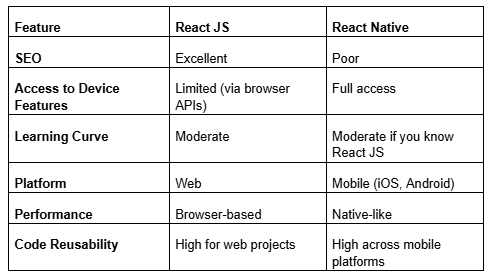.webp)
Emwiongbon Ivie Maryann
C.ITP Emwiongbon Ivie Maryann, MCPN, is a software developer focused on responsive, accessible, user‑centered web apps using React, TypeScript, and Next.js. . Chartered IT Practitioner and MCPN member; author of "Boilerplate Blueprint."
Article by Gigson Expert
When building applications, developers often face a critical decision: should they use React Native or React JS? Both are backed by Meta (formerly Facebook), share similar core principles, and are powered by JavaScript, but they both serve different purposes.
React JS and React Native are two powerful tools in the JavaScript ecosystem, each designed for different use cases. While most projects will choose one based on their target platform, some companies use both, leveraging ReactJS for web applications and React Native for mobile apps.
Choosing the right framework depends on your project goals, target platforms, and team expertise. In this article, we’ll explore the key differences, similarities, use cases, and decision-making factors to help you pick the right tool for your next project.
Understanding the Basics
We must understand the basic concepts and example use cases of both frameworks so that we can stay afloat with both concepts throughout this article.
What is ReactJS?
ReactJS is a JavaScript library for building fast, interactive user interfaces primarily for the web. It allows developers to create reusable UI components, manage state efficiency, and handle complex rendering logic with ease.
React JS applications run in the browser and are often combined with other tools like Next.js or Redux for full-scale web development.
Example Use Cases
- Social Media Platforms
- Facebook Web (News Feed, Messenger web version)
- Instagram Web (Browsing, likes, DMs)
- Twitter Web (Timelines, real-time updates)
- E-commerce Websites
- Shopify Admin Web (Merchant dashboard)
- Amazon’s Seller Central (Seller tools interface)
- Etsy Web App (Marketplace browsing & management)
- On-Demand Service Platforms
- Uber Web (Ride booking and trip management)
- Airbnb Web (Property search, booking, and management)
- Fiverr (Freelancer search and hiring)
What is React Native?
React Native is a framework for building mobile applications using JavaScript and React principles. Instead of rendering to the browser DOM, React Native uses native components, enabling apps to run on iOS and Android with a single codebase.
This framework is particularly appealing for teams that want cross-platform mobile apps without maintaining two separate codebases, allowing them to build applications for both Android and iOS from a single codebase.
Just to mention, there are some native development frameworks provided by Apple or Google that do not support cross-platform frameworks, and examples of such include;
- Only iOS Apps - Use Swift or Objective-C with Apple’s Xcode and UIKit/SwiftUI frameworks.
- Only Android Apps - Use Kotlin or Java with Google’s Android Studio and Android SDK.
Example Use Cases of React Native
- Social Media Apps
- Facebook (Parts of the app, since React Native was created by Facebook)
- Instagram (Used React Native to implement features like push notifications)
- Pinterest (Certain parts of the mobile experience)
- Mobile E-commerce Apps
- Shopify (Shopify’s mobile admin app uses React Native)
- Walmart (Migrated parts of their app to React Native for speed)
- Flipkart (Uses React Native for performance and UI consistency)
- On-Demand Service Apps
- Uber Eats (Restaurant dashboard is built with React Native)
- Delivery.com (Order and delivery management features)
- Townske (City guide app for travellers)
Key Similarities
Now that we understand the basic concepts of both React JS and React Native, let’s take a quick look at how similar they are. From their syntax to component structure to state management, and finally developer tools, let's see what they share:
- JavaScript & JSX – In terms of syntax, both use JavaScript and JSX syntaxes to build components.
- Component-Based Architecture – Applications of both frameworks are made of modular, reusable components.
- State Management – Maintain similar concepts for managing data flow, such as hooks and context.
- Developer Tools – React DevTools can be used to debug both environments.
Although both React JS and React Native have some similarities, both also have distinct differences in terms of performance, styling, and rendering.
Key Differences
- Platform Target
- React JS - Web applications (run in browsers).
- React Native - Mobile applications (runs on iOS and Android).
- Rendering
- ReactJS uses the Virtual DOM to update UI elements in the browser.
- React Native, on the other hand, uses native APIs to render real mobile UI components, resulting in smoother performance and access to platform-standard UI elements that feel familiar to users.
- Styling
- React JS uses CSS, SCSS, Tailwind, Material UI, and other CSS libraries.
- React Native uses JavaScript-based styling (similar to inline styles) with its style properties. This is often implemented through the built-in StyleSheet API, which provides a CSS-like abstraction, making the transition smoother for web developers familiar with traditional styling.
- Performance
- React JS performance depends on the browser rendering speed.
- React Native can be faster for mobile apps since it uses native components, but it may require optimization for complex animations or heavy computations.
- Third-Party Libraries
- ReactJS has a wider range of web-focused packages.
- React Native has a growing ecosystem but sometimes relies on native modules for device-specific features (e.g., camera, GPS).
Now that we understand the similarities and key differences between React JS and React Native.
A point to note is that, if your primary audience is on the web, ReactJS is the natural choice. For mobile-first products, React Native is the better fit. In some cases, teams adopt a hybrid strategy, building a web experience with React JS and a mobile companion app with React Native, reusing shared logic to save time and maintain consistency.
Let’s explore scenarios that might guide you in choosing one over the other.
When to Choose ReactJS
You should lean toward ReactJS if:
- Your primary target is the desktop and mobile web.
- You need SEO optimization (React Native is not ideal for SEO).
- You’re building a content-heavy site, like blogs or news platforms.
You already have a backend and only need a front-end web client.
When to Choose React Native
You should choose React Native if:
- You want cross-platform mobile apps from a single codebase.
- Your app requires access to native device features (camera, push notifications, GPS).
- You have limited resources but want to reach both iOS and Android users quickly.
- You already have ReactJS experience and want to enter mobile development faster.
In the table below, I have highlighted the Pros and Cons at a Glance, which would help you to choose between the two choices.

Decision Factors to Consider
Choosing between React JS and React Native isn’t about which is “better,” but about which is right for your project’s goals.
If you’re targeting web browsers, React JS is the clear choice.
If you need mobile apps for both iOS and Android, React Native offers efficiency and a native-like experience without building two separate codebases from scratch.
As a team or an individual, when deciding between the two frameworks, consider:
- Project Type – Is it primarily web or mobile?
- Budget & Time – Can you afford to maintain separate codebases?
- Team Skills – Do your developers already know React?
- User Experience – Do you need a truly native mobile feel?
FAQs
1. Can I use React Native for web apps?
Yes, with React Native for Web, but it’s not as mature as React JS for browser-based apps.
2. Is React Native as fast as native development?
It can be close, but highly complex apps may still perform better with fully native code.
3. Do I need to learn Swift or Kotlin to use React Native?
Not necessarily, but knowing them helps when writing custom native modules.
4. Which is easier to learn—React JS or React Native?
ReactJS is generally easier because you only deal with the web environment.
5. Can I reuse ReactJS components in React Native?
You can often reuse business logic, state management, and patterns between the two. However, UI components are not directly interchangeable because ReactJS renders to the DOM (e.g., <div>, <p>) while React Native renders to native components (e.g., <View>, <Text>). This means the structure often needs adjustments, even though the underlying logic can be shared.




